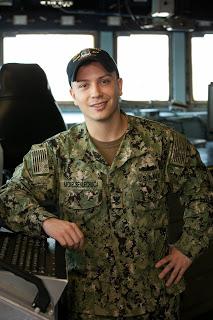
by Ricky Burke, Navy Office of Community Outreach
Photo by Mass Communication Specialist Senior Chief Gary Ward
NORFOLK, Va. – A 2013 Fremont High School graduate and West Haven, Utah, native is serving in the U.S. Navy aboard the guided-missile destroyer USS Mason.
Navy Petty Officer 2nd Class Kaidan Mickelsen is a fire controlman (aegis) aboard the warship, based in Norfolk, Virginia. USS Mason is named after Secretary of the Navy John Young Mason and Distinguished Flying Cross Recipient Ensign Newton Henry Mason.
A Navy fire controlman (aegis) is responsible for managing the networking of the fire control radars for the tactical procedures of the ship.
“I really like getting to do troubleshooting which involves diagnosing a problem and fixing it,” Mickelsen said.
Mickelsen credits success in the Navy to many of the lessons learned in West Haven.
“Hard work and perseverance was instilled in me from my family members and community as a whole,” Mickelsen said.
U.S. Navy sailors, like Mickelsen, are stationed both stateside and on the high seas aboard surface ships around the world. USS Mason is one of more than 60 ships on the east coast of the United States as part of Naval Surface Forces, U.S. Atlantic Fleet.
U.S. Navy ships are deployed globally, and their presence helps the Navy control the sea. Sea control is vital to project power, secure common areas, deter aggression and assure allies when and where desired.
Due to its extensive combat capability, the Mason is able to fire Tomahawk Cruise Missiles and other weapons as part of sustained combat operations against targets on and below the sea, in addition to hitting targets hundreds of miles over the land.
The ship is equipped with the Aegis Combat System, which integrates the ship’s electronic sensors and weapons systems to defend against anti-ship missile threats. The ship’s air search and fire control radar provides continuous search and tracking of hundreds targets simultaneously.
The crew of more than 300 sailors build a strong fellowship while working alongside each other. The sailors are highly motivated, and quickly adapt to changing conditions as part of a busy life of specialized work, watches and drills.
“We are like a family, we have good camaraderie where everyone takes care of one another,” Mickelsen said.
Though there are many ways for sailors to earn distinction in their command, community, and career, Mickelsen is most proud of making the rank of petty officer second class.
“Being a second class is a position that is earned not given, and most people look at you as their closest leader,” Mickelsen said. “You are supposed to be an expert in your field and leaders and subordinates depend on you to solve problems.”
As a member of one of the U.S. Navy’s most relied upon assets, Mickelsen and other sailors know they are part of a legacy that will last beyond their lifetimes, one that will provide a critical component of the Navy the nation needs.
“Serving in the Navy means having the opportunity to serve my country,” Mickelsen added. “Being homesick is good because it shows that I actually have something worth protecting.”